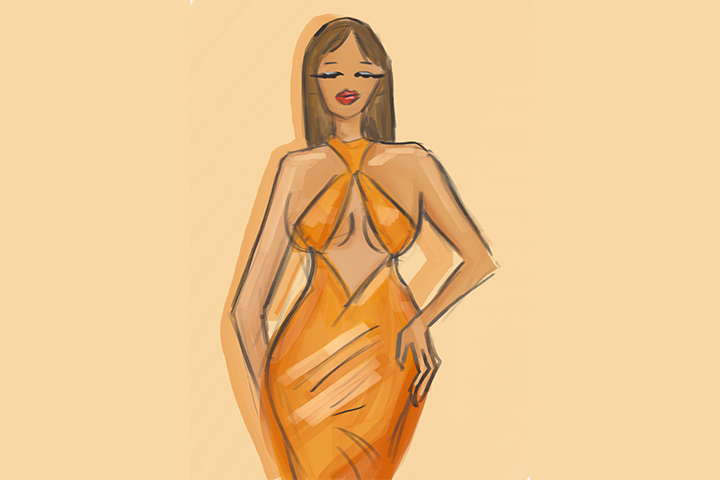Blinding neon spandex, animal-print velvet and flimsy knitwear that lasts a single wash cycle; precarious cutouts and laddered holes; curve-hugging, cleavage-baring, waist-cinching dresses on curvy models who look like real-life versions of Jessica Rabbit: These are the holy tenets upon which stands the 21st century phenomenon colloquially known as BBL, or Brazilian butt lift, fashion.
BBL fashion caters to a very specific body type — large breasts, small waists with flat stomachs and large, augmented buttocks — achieved almost exclusively through cosmetic surgery. It has infiltrated social media marketing, popular culture and seasonal trends.
But not only is BBL fashion impractical and oftentimes grotesque, it epitomizes the intersection of everything that is wrong with the fashion industry today: the pressures of cosmetic surgery, the trend cycle of women’s body types and the rise of harmful, unsustainable fast fashion.
The BBL is a cosmetic surgery procedure where abdominal fat is removed through liposuction and reinjected into the buttocks to achieve an extreme hourglass shape. It has the highest mortality rate out of any cosmetic surgery at 1 in 3000 deaths.
The procedure is also pricey: Depending on the surgeon, a BBL can set you back up to $30,000. This can result in women seeking cheaper surgery at shady “chop shops,”causing the mortality rate to rise even further because of unaccredited providers administering lethal fat injections.
Yet, the surgery remains one of the most popular, with over 61,000 buttock augmentations performed in 2021 alone.
BBL fashion serves as marketing for this procedure. Styles made for artificially enhanced body types have found their way into the mainstream, placing even greater pressure on women to conform to the standard of “slim-thick” hourglass figures. Touted by fast-fashion retailers such as SHEIN, Fashion Nova, PrettyLittleThing, Boo Hoo and more, these pieces are often cheaply, unethically made, and easily disposable.
While BBL fashion itself can’t exactly be called a “microtrend,” the clothing that exists within this scope certainly follows the harmful pattern of buy-wear-dispose-repeat that defines fast fashion. Fast fashion amplifies the beauty standard by advertising through influencers that have achieved this body type. A visit to the PrettyLittleThing site, for example, yields hundreds of bodycon dresses on hourglass-shaped models — a large chunk are made of cheap polyester and most cost under $60.
Besides the danger of the surgery itself, BBL fashion is alarming because it represents the disturbing cycle of the fashion industry turning women’s body types into cyclical trends. The ‘90s heroin chic popularized clavicles, thigh gaps and concave stomachs. The Y2K look in the early 2000s was defined by the low-rise jean and the micro-mini skirt — all indicators of thinness.
Then, the 2010s gave rise to the BBL.
The procedure gained traction quickly, with the number of BBLs increasing by 90% since 2015. This sudden increase in popularity is often attributed to celebrities like the Kardashians, who seemingly ushered in a new era of women’s bodies which 2014 Vogue dubbed “The Era of the Big Booty.”
It is important to note that throughout the eras of fashion that glorified thinness, Black women and other women of color were often derided for naturally curvy bodies. But now, even they are under increasing pressure to receive BBLs because the aesthetic of a curvy body has been appropriated by the white-dominated cosmetic surgery and fashion industries and repackaged into an unattainable ideal — one that is often based in genetics.
BBL fashion feeds off the commodification of women’s bodies at the expense of all women, especially women of color. Turning women’s bodies into trends is misogynistic and pits women against each other.
The surgery, often pushed by the industry as an empowering choice for women, pushes racist, anti-feminist beauty standards and treats women’s body types like commodities to be arbitrarily bought and sold.
All this comes at the expense of women of color, whose ethnic features like bumpy or large noses, wide hips and monolids are often shunned in favor of rhinoplasty, liposuction and eyelid surgery to adhere to white beauty standards. The BBL takes this premise to the next level by co-opting a body type common for Black women and contorting it into a standard largely unattainable without surgery.
While the rise of the BBL has certainly brought unprecedented attention to body types previously considered too large for the industry, it has come at the expense of simply repackaging the harmful ideals of fashion into a new form.
The message seems to be you can be curvy, as long as the fat is deposited in all the “right places.” Cellulite and stretch marks must be hidden. Small breasts are a big no-no. And just like that, we fall into yet another destructive cycle of unsustainability — whether it is in unsustainable beauty standards or unsustainable garments.
BBL fashion needs to go — and consumers need to take a stand against the blatant exploitation of women’s bodies by the fashion and cosmetic surgery industries.


























